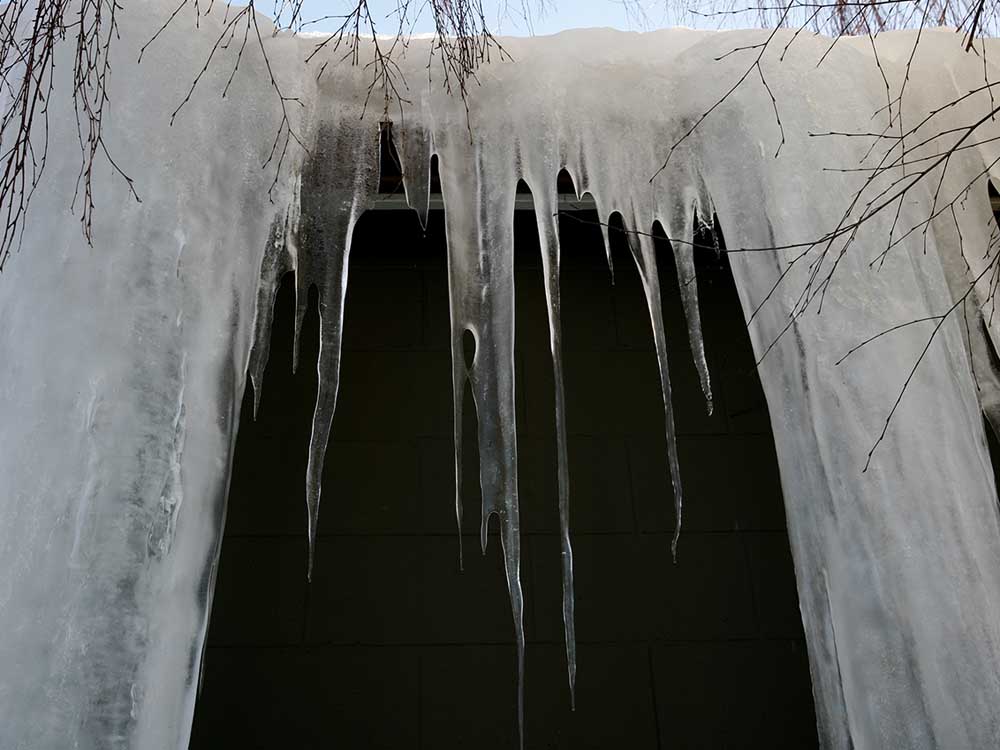Disaster creates opportunity for snow and ice contractors
Published 1:54 pm Friday, January 27, 2017

- An ice dam on a building in Bend, Thursday, Jan. 27, 2017. (Dean Guernsey/Bulletin photo)
Cricket Kadoch paid an out-of-state contractor $2,850 for six hours of work removing snow and ice from the roof of her southwest Bend home, and she was happy to do it.
“I’m having a little bit of hope today I can move back into the house next week,” Kadoch said Thursday, while staying in a hotel with her two children. They left the house last week, after ice dams formed for a second time, and the leaks were so bad that water started running down the inside of her front door.
The contractor, Joe Mann of SteamIceDamRemoval.com, is one of at least two ice-removal experts who arrived in Bend after hearing about the recent storms and the widespread problems with ice dams that formed on roofs. But out-of-town storm chasers aren’t the only contractors taking advantage of Bend’s situation.
Local people are getting into the game and charging exorbitant rates, said Jake Woodruff, owner of Northwest Quality Roofing in Bend. Woodruff said he talked to a Sisters resident on Saturday who was quoted $600 an hour for ice dam removal.
“They were requiring a $1,200 check before they stepped on the roof,” he said.
Snow and ice removal contractors — even when working on a rooftop — do not need a license in Oregon because it’s considered cleanup work, in the same category as gutter clearing and pressure washing, said Stan Jessup, enforcement program manager at the Oregon Construction Contractors Board. Nevertheless, he encourages consumers to use licensed contractors so their bonding and insurance can be verified by the state.
“What happens if they fall off your roof?” Jessup said. “There’s potential liability there.”
The state does not regulate fees, even in disastrous situations, Jessup said. The Better Business Bureau Northwest, which covers Oregon and Washington, could not find a record of complaints from Central Oregon about ice dam removal, a spokeswoman said.
Even more than snow removal, ice dams create an opportunity for contractors such as Mann because they’re difficult to tackle, and when water builds up behind them, they lead to leaks inside the home, said Fred Zimmerman, who runs the website for Mann.
“People are in an absolute panic when they have water coming in their houses,” he said. “They don’t know what to do.”
Zimmerman said local contractors do not have the equipment or the expertise to deal with ice dams, which are rarely seen in Bend, but have become common in this winter.
Earlier this month, Zimmerman, who handles the operation from Connecticut, said he was receiving 100 calls a day from Bend. Some of the callers were contractors who were just looking for information on dealing with ice dams. He connected with Brennan Morrow, the owner of a solar tube installation business in Bend, who’d gone into snow removal following the storm. Morrow said his crew couldn’t deal with very large ice dams and started referring the work to people sent out by Zimmerman from Minnesota and North Dakota.
Mann and other contractors use low-pressure, high-temperature steam to melt away ice dams. “Every steam truck in the West Coast area came to Bend,” Morrow said. “They were coming here as quick as they could.”
At $475 per hour, Mann’s services aren’t cheap, but he believes it’s reasonable, and he claims the method is one of the few ways to remove ice without damaging the roof.
“There’s guys out there hitting people’s roofs with hammers, using hot pressure washers,” Mann said. “I’ve seen many, many roofs completely destroyed by people taking ice off them the wrong way.”
Woodruff, who recently acquired a steaming machine in order to respond to the calls for ice dam removal, agreed other methods risk damaging rooftops. Even if the tools never touch the shingles, the force could loosen or damage roofing material or poke holes into the roof.
“I’ve had people tell us, ‘I was up there with a sledgehammer,’” he said. “All that does is create work for me in the summertime.”
Before he acquired the steamer, which is booked for the next three weeks, Woodruff said his company was using ice melt. “It’s not the best practice,” he said.
Zimmerman, also a roofer, said he recommends using calcium chloride, rather than magnesium-based products, to avoid discoloration and rusting out gutters. If special equipment isn’t available, he said one could gently chisel a channel into the ice and pour in ice melt to encourage breaking up the ice dam.
Kadoch battled ice dams and leaks several times over the last two weeks. First it was a 12-inch-thick ice dam in one corner of the roof, which her roofing contractor removed for $400. At the time she was grateful the contractor returned her phone call on a Saturday and showed up the following Monday, Martin Luther King Jr. Day. She thought the problem was solved, but weather and other circumstances conspired to form more ice dams.
“There was actually ice in my attic,” Kadoch said. She concluded the problems wouldn’t end until all the snow and ice was off her roof. Her insurance company agreed to cover Mann’s work, and his crew was on the scene Wednesday, the same day she called. Kadoch said the contractor’s responsiveness was all that mattered.
“The whole time this was going on, when I was shoveling day and night, I was trying to save my home and keep my family safe,” she said. “It changes priorities.”
— Reporter: 541-617-7860, kmclaughlin@bendbulletin.com
“There’s guys out there hitting people’s roofs with hammers, using hot pressure washers. I’ve seen many, many roofs completely destroyed by people taking ice off them the wrong way.”— Joe Mann, contractor






